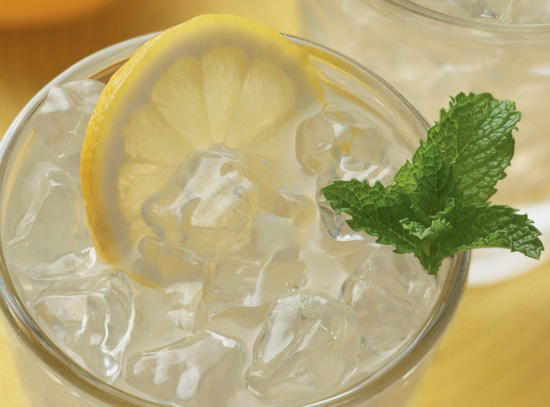
Lemon and mint add a tangy flavor to tap water.
Water is the basic ingredient for all refreshing drinks, as well as being essential for good health. But water alone can be a little dull, so here are some traditional methods to satisfy your taste buds while quenching your thirst.
Drinks should quench your thirst and refresh you without sending your blood sugar soaring. Commercially produced drinks often contain too much sugar, so borrow your grandmother’s cookbook and make your own.
Advertising by bottled water companies gives consumers the impression their product is safer and healthier than tap water. As a result, world consumption of bottled water has grown enormously in the past 10 years. However, you may be better off drinking the elixir of life straight from the tap. Here are three reasons why.
1 Producing and delivering bottled water creates greenhouse gases, and most discarded plastic bottles end up in landfill sites.
2 Scientists found that many bottled brands contain higher levels of bacteria than tap water.
3 Drinking bottled water can cost up to a thousand times more than tap water.

Lemon and mint add a tangy flavor to tap water.
• The amount of coffee you need will depend on personal taste, water quality and the type of coffee maker you are using. Generally, when using a filter coffeemaker, allow about 1 tablespoon (15 ml) coffee per 1 cup (250 ml) water. With hard water, which contains lime, use more coffee.
• Store coffee beans in a dry, cool, dark location and keep them in a tightly closed container or they will get stale.
• Store vacuum-packed ground coffee for several months if unopened. Once opened, keep in an airtight jar in the refrigerator.
• Ground coffee loses its flavor quickly and should be used within 6 months.
• Use a coffee grinder or spice mill to make freshly ground coffee.
STORE COFFEE BEANS in a tightly closed container OR they will get STALE.
GOOD TO KNOW 
Coffee substitute & chicory coffee
In times of crisis, when coffee was too expensive or simply unavailable, people often drank substitutes made from dandelion or chicory roots, or used them to stretch out their real coffee. When people turn to such substitutes now, it’s usually for health reasons. Coffee made from chicory is more easily digested, caffeine-free and contains fewer tooth-staining tannins than coffee beans.
After water, tea is the most widely consumed drink in the world. The term “herbal tea” usually refers to an infusion of leaves, flowers, fruit, herbs or other plant material that doesn’t include traditional tea leaves.
• Infuse black tea leaves with boiling water then steep for 3–5 minutes. Strain before serving.
• Steep green tea in hot water at 175°F (80°C) for only 2 minutes.
• When water has a high lime content, use strong tea blends or run the water through a filter.
• Store tea in a dry container with a tight-fitting lid. Special metal or porcelain containers and opaque bags are ideal for this.
• Don’t keep opened packets of tea in the refrigerator. The sensitive leaves can be damaged by fluctuations in humidity.
• For long-term storage, place unopened tea in the vegetable drawer in the refrigerator.
• Always store the same type of tea in a container, as tea will quickly pick up other flavors, which can ruin its subtle nuances.
• Make delicious herbal teas with rosehips or mint. Depending on the season you can boost their flavor: In summer, use lemon or lime peel with mint tea; in winter, use cinnamon or cloves with rosehip tea.
Iced tea is a wonderfully thirst-quenching drink for hot days and easy to make.
1 Brew 3–4 teaspoons (15–20 g) tea leaves in 1 quart (1 L) water and let it steep for 3 minutes.
2 Stir in the juice of 11/2 lemons, sweeten to taste, and strain over about 25 ice cubes. The tea cools quickly and doesn’t become bitter.
3 Flavor it according to taste with apple juice, fruit nectar, citrus fruit or mint leaves.
There’s nothing quite like the flavor of traditional homemade lemonade, which is refreshing and often healthier than store-bought versions.
1 Boil the zest of 6 organic lemons with 11/4 cups (280 g) sugar and about 2 cups (500 ml) water. Simmer briefly, cool and add the lemon juice.
2 Strain the lemonade concentrate and pour it into a glass jug. Fill it up with ice cubes and cold water.
• Honey, ginger or rosewater will give lemonade a highly original flavor.
• Limes and oranges can be also be used to make equally refreshing drinks.
Get more vitamins and minerals into your diet by drinking freshly made fruit juices or whipping up thick and frothy smoothies from frozen fruit.
• Make a delicious fruit drink by cutting up your choice of fruits and puréeing them in a blender with the juice of half a lemon, together with 1/4–1/2 cup (55–115 g) sugar. Adjust the amount of sugar according to the fruit used and your taste.
• For a berry punch that will serve about 15 people, put 2 pounds (1 kg) raspberries and strawberries, the juice of a lemon and 6 cups (1.5 L) mixed fruit juice in a punch bowl and cool for several hours, stirring from time to time. Shortly before serving, add two bottles of mineral water, followed by ice cubes.
• Keep your punch cold by freezing slices of citrus fruits and using them in place of ice cubes.
• Blend frozen fruit such as bananas, strawberries, milk and a touch of honey to make a frothy smoothie.
FREEZE CUBES of fruit to chill A DRINK without diluting it.